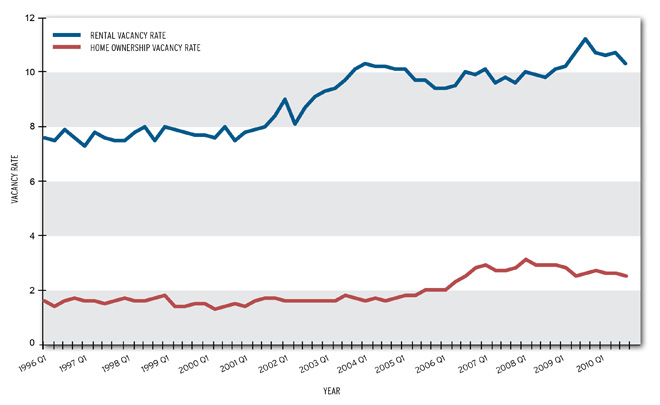The economic crisis soldiers on. A friend’s daughter, her boyfriend, and their two kids recently moved back home because they don’t have the money to pay rent on their own place. Now 9 people are sharing a 900 square foot home. When we talk in statistics, we sometimes lose sight of the real, complex lives behind them. But other times, numbers can convey the enormity of a problem.
Between 2000 and 2007, the U.S. population increased by about 1 percent per year, and the number of households expanded by 1.4 percent a year—an extraordinary occurrence. For household formation to outpace population growth meant that the average household size was shrinking; more people living alone rather than sharing homes with parents, friends, or adult children. This expansion wasn’t sustainable. Looking at the past two years, household formation has fallen dramatically and now stands well below the rate of population growth. If the household formation rate had stayed at its 2000-2007 average, we’d have seen another 1.8 million households by 2009. The shortfall explains why, over the past few years, vacancy rates have reached their highest levels on record. One in 10 rental units is now vacant, as are 2.5 percent of homeownership units.
What’s happened to these disappearing households? The same thing that happened to my friend’s daughter—they’re moving in with parents, aunts and uncles, or siblings. For some, the stay will be short, but for others it will stick. And what does this mean for children? In most cases, it’s better than living in a shelter. But several studies link overcrowded homes with poor parenting and mental health, and children growing up in crowded housing are more likely to fall behind in school. I’m not telling my friend; I think she knows already.
Vacancy Rates in Metropolitan Areas
See Bob Lerman’s recent post for more on the apparent paradox between families living in substandard conditions alongside record-high home vacancy rates.
Tune in and subscribe today.
The Urban Institute podcast, Evidence in Action, inspires changemakers to lead with evidence and act with equity. Cohosted by Urban President Sarah Rosen Wartell and Executive Vice President Kimberlyn Leary, every episode features in-depth discussions with experts and leaders on topics ranging from how to advance equity, to designing innovative solutions that achieve community impact, to what it means to practice evidence-based leadership.
